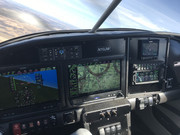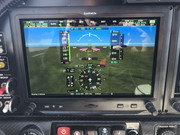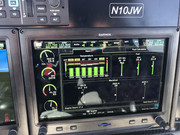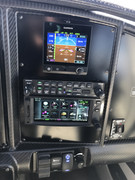OK, here's the debrief from this morning's webinar. A couple additional things they announced first, and answers to the questions are below:
First, the 36-series Bonanzas have been added to the list of aircraft that will be supported on the GFC 500, and the certification work on that is currently in progress. Even though I think their initial certification on the GFC 600 was done in the A36, it's still an awful lot of $$$ for a single. The other planes they're certifying the GFC 600 for are twins and turbines. I can't believe it took them this long. The A36 crowd has been rightfully pretty angry about this, but I'm glad Garmin got their head on straight here.
There was one other thing Garmin introduced yesterday that nobody noticed: The GTX 335D and 345D transponders with antenna diversity. It sounds like this might be a requirement in Canada once they require ADS-B, so it's good that it's finally available - I think these might be the first. I believe the root of the reason Canada is wanting antenna diversity is that they have vast swaths of land up there without even any radar coverage, and they don't want to implement the extensive land-based network that we have here in the US. Using satellites instead of the ground-based system, or having airplanes flying above and below potentially means that the bottom-antenna-only installations most of us have wouldn't work well in Canada. No word yet on an upgrade path, and these suckers are pretty expensive: $7995 for the 345D, which is an extra $3K over the regular 345.
For those interested in the GPS 175 and GNX 375, there is a trainer app on the iOS app store... Or, at least there will be. I don't see it yet.
Answers to the questions:
1) What differences in capability are there between the G3X Touch and the G500 TXi?
The following things are present on the TXi that are not on the G3X Touch:
- Twin engine support
- Pilot/Copilot PFD installations
- HSI map
- More modern hardware and a nicer screen - Display technology is rapidly evolving, and the G3X Touch is already 5 years old.
- Additional third-party I/O. They showed only the GAD 29B as an option here, not the GAD 43e, so the interfacing options of the G3X Touch are similar to the G5 rather than similar to the TXi.
- Database Concierge
- Remote audio panel support
- Non-Garmin attitude-based autopilot support
- 3rd-party Nav radio support on the on-screen HSI.
- Airborne weather radar support (not datalink, but actual radar like the BendixKing RDR-2000 and Garmin GWX series)
- Support for the GDL 69A, GDL 88, and GSR 56 datalinks
- Many more display configurations - Only four are certified on the G3X Touch, while something like 28 are certified on the TXi. (See question 2.)
2) With the 10" + 7" package installed, is it possible to switch the 7" display between PFD/MFD and EIS, or is it limited to being one or the other?
It actually can't do either. There are only four certified display configurations:
- Single 7" display, either PFD-only or PFD+MFD. No EIS.
- Dual 7" displays, one PFD, one MFD. EIS strip available on the MFD in this configuration.

- Single 10" display, PFD+MFD with optional EIS.

- Dual displays, one 10" PFD and one 7" MFD, with optional EIS strip on either display.

3) Are there any options for battery backup?
Yes, third party options like the
TCW.
4) What are the possible options for display backup?
Dual G3X displays have cross-check and reversionary mode similar to the G1000, where EIS will appear on the remaining display.
Also, and this is pretty cool to me: Even a G5 will function not only as a backup display, but will cross-check the AHRS from the G3X Touch.
Even cooler: If you have a G3X Touch, a G5, and a GFC 500, loss of either the G3X or the G5 does NOT take out your autopilot - Either one of them can control the GFC 500, and neither is "in charge" - They're constantly communicating, and as noted above, they share the bugs and autopilot modes. So, if you lose one of the two, the plane keeps flying along as if nothing happened, without so much as a button press necessary. This is a level of backup pretty much unheard of in GA until now.


5) Does the G3X Touch support multiple nav sources?
Yes, as long as the NAV radios are on the
approved interfaces list.
6) Does adding a FlightStream 510 to the GNX 375 or GPS 175 add anything other than Database Concierge?
No.
7) Can a GMA 350c do any voice control of the G3X Touch?
No. None of the newly introduced gear (G3X Touch, GPS 175, GNX 375) supports Telligence voice commands.
8) With multiple G3X displays/G5s, do things like altimeter setting automatically flow between them?
Yes. Baro setting is sent from the G3X to the G5. Heading, altitude, and airspeed bugs sync bi-directionally. Flight director and GFC 500 mode annunciations are displayed on both.
9) Is the dual screen 10+7 configuration listed at $14,865 on the web site single or dual AHRS? Any reversionary mode?
Single AHRS. There is display reversion in the dual display configurations. If you have a G5 as backup, there is display reversion there, obviously with only the PFD if the G5 is all you have left. There is also miscompare monitoring between the G5 and G3X Touch AHRS.
10) Do the GNX 375 and GPS 175 support flight plan crossfill with GTN and GNS series navigators?
No, not currently. Only the ADS-B from the 375 will be shared.
11) Can the G3X Touch be used by FIKI aircraft?
No.

Other tidbits:
GNX 375 does NOT work with ForeFlight right now, but they are planning to support it later.
GPS 175/GNX 375 do not support VNAV like the GTN series, but they will do "VCALC" like the GTN used to do before VNAV.
G3X Touch does not support EIS streaming to an iPad the way the G500 TXi does.
G3X is about 5 years old, so screen isn't as nice as the TXi displays. Only 4 display configurations certified.
G3X Touch is mostly limited to interfacing with other Garmin products.
G3X Touch does have a GPS that can take over if your navigator fails.
G3X Touch can get XM radio and weather via the GDL 50R/51R/52R units, which are relatively cheap.
They're running a GNS to GTN upgrade program, up to $5000 credit for your GNS when buying a GTN, plus additional credit if you're buying a GTX 335/345 and/or GMA 345/350/350c.






